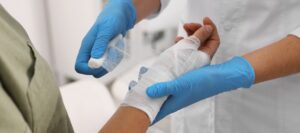 All types of open wounds come with some level of drainage, also known as exudate. Purulent, sanguineous, serosanguineous and serous are 4 different types of wound drainage that consist of a combination of pus, blood and other fluids. Drainage varies in color, texture and severity. The type and amount of drainage are key indicators of wound severity, as well as if your wound is infected or in the healing process.
All types of open wounds come with some level of drainage, also known as exudate. Purulent, sanguineous, serosanguineous and serous are 4 different types of wound drainage that consist of a combination of pus, blood and other fluids. Drainage varies in color, texture and severity. The type and amount of drainage are key indicators of wound severity, as well as if your wound is infected or in the healing process.
Wound drainage may be caused by surgery, injury or anything that results in an open wound. Drainage is normal during the inflammatory stages of a wound, but becomes more cause for concern as the wound enters other stages of the healing process. Drainage can be a sign of infection, but not always. The actual appearance of drainage will indicate if the wound is healing normally or if it requires further medical attention.
It’s important to be able to identify different types of drainage in order to best care for your wounds and discuss possible treatment options with your doctor.
4 Types Of Wound Drainage
1. Serous Drainage
A thin, watery and clear substance exiting the wound is classified as serous drainage. When your wound is fresh and going through the inflammatory wound healing stages, it’s perfectly normal to experience this type of drainage. If you notice an overwhelming amount of serous drainage, it may indicate high bioburden, or the presence of unsterilized bacteria living on the wound.
2. Purulent Drainage
You may be experiencing purulent drainage if liquids draining from your wound are a milky texture. Purulent can be shades of green, yellow or gray, and tend to be rather thick in consistency but can also be thin. This type of drainage often indicates infection of the wound.
The reason that purulent drainage is off-color and thick relates to pathogenic microorganisms and dying bacteria, as well as inflammatory and white cells invading the infected area. If your infection worsens, the amount of purulent drainage increases. This type of wound drainage requires special attention and medical care.
3. Sanguineous Drainage
Sanguineous drainage is fresh blood that commonly leaks from deep wounds of full or partial thickness. It is perfectly normal to see small amounts of bloody leakage during the inflammatory stage of a wound. It is not as normal to see this type of drainage during other stages of healing, and may indicate the wound has undergone additional trauma. Re-hitting the wound, picking at the wound, or changing bandages can all cause this type of drainage to reappear during the healing stage.
4. Serosanguineous Drainage
Serosanguineous is the most common type of drainage. It is thin, watery and tends to be pink in color, but can also be shades of darker red. The pink/red coloring has to do with red blood cells in the fluid, a sign of capillary damage.
How Much Wound Drainage Is Too Much?
Doctors pay close attention to the color, texture and quantity of wound drainage. The exact level of drainage you are experiencing can be broken down by the percentage of total saturation.
Scant Drainage is classified as anything below 25% saturation, indicative by slightly moist dressings.
Minimal Drainage is generally no more than 25% saturation, but more drainage than scant. Dressings will be mostly damp.
Moderate Drainage is anything between 25% and 75% saturation, indicative by soaked dressings.
Copious Drainage is the most severe type of drainage, classified by 75% or more saturation. This level of drainage is almost always serious and requires medical attention.
Wound Drainage Odor
The odor of wound drainage is another key factor when determining overall severity and the best form of treatment. Wound odor may signal an infection or a dirty bandage. Different microorganisms have distinct smells, many of which are instantly identifiable by experienced health professionals. Once you catch a whiff of one, it’s easy to recognize it again in the future. For instance, an ammonia-like smell is notorious of Proteus, and a sickly sweet scent is linked with Pseudomonas.
If you notice strange odors coming from your wound, it may or may not be a big deal. It’s always best to get medical attention as soon as possible to make sure you do not have a more serious underlying infection.
Treating Infected Wounds
In most cases, proper wound care will prevent infections and help expedite recovery. The best way to prevent infection is to wash your hands prior to dressing your wounds, keep bandages clean and regularly changed, and always be on the lookout for early signs of infection. At the first sign of infection, visit Urgent Medical Center for fast, friendly and affordable healthcare you can count on.





